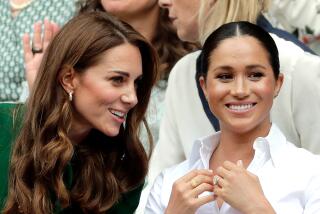A retrospective full of Grace
- Share via
Monte Carlo — TWENTY-FIVE years after her death, at a time when much of the royal glamour and scandal that once fueled Monaco has faded, Grace Kelly is back to give the tiny principality a chic shot in the arm.
An enormous exhibit, “The Grace Kelly Years,” opened this month at the Grimaldi Forum, providing an unusually detailed snapshot of the bricklayer’s daughter who grew up to be a movie star and a princess in what is inevitably referred to as a fairy-tale life.
Items and artifacts ranging from old childhood scrapbooks and high school yearbooks to letters signed “Affectionately, Hitch” and passionate telegrams from Prince Rainier are included in the exhibit, as are her wedding dress and the famous “Kelly” bag by Hermes. (The exhibit remains in Monaco until Sept. 23, then travels to London, Paris and New York.)
The items, many of which have never been displayed, are set against a backdrop of clips from some of Kelly’s 11 movies, her Oscar acceptance speech, old newscast-style film of her transatlantic voyage to her Monaco wedding and family home movies. They are organized in about 30 vast chambres, or rooms, that take visitors through her life. The “Philadelphia Room,” “New York Room” and “Hollywood Room” are the biggest; “The Secret Woman” is the most intimate.
But the aim of the show, according to its curator, Frederic Mitterrand, a nephew of the late French president, was to reveal a Grace Kelly truer than the tabloid image he believes many people, especially Americans, hold.
“There was too much trash around her persona,” he says. “I myself had some idea of her, but mostly from the stereotype. I hope people will come away with a sense of how tender she was. She also had a streak of melancholy and was never totally at peace. But she truly understood the art of living.” Kelly, who would have turned 78 this year, apparently also felt her life was more complex than people realized.
“Fairy tales are about imaginary people,” read Kelly’s words scrolling across the wall in French in the stark room that opens the show. “But me, I’m a person who exists.” That’s true -- but her existence seems as freakishly charmed as it ever did, possibly more so given the sheer volume of idyllic memories unearthed for the exhibit.
Home movies of her Kennedy-esque clan at the beach, featuring her picture-perfect Irish Catholic family from Philadelphia, are almost as dazzling as those of Princess Grace with her three photogenic kids and the rakish Prince Rainier on yachts in the Mediterranean and skiing in the Alps.
Two of her bridesmaids, Rita Gam and Sally Parrish Richardson, showing their age as Kelly never would, wax rhapsodic about their long-dead friend on-screen in a small movie theater. Richardson wistfully touches the “bridesmaid bracelet” she was given at Kelly’s 1956 wedding to Rainier and says she never takes it off.
Kelly’s Oscar for the 1954 film “The Country Girl,” peeking out of a case in the huge “Hollywood Room,” comes off as just another of the many trophies from her life, real or metaphorical, that almost overwhelm the visitor.
Fortunately for the PR-minded organizers at the Grimaldi Forum, whose idea it was to stage the show, Kelly apparently was one of the world’s biggest pack rats. She may have never thrown anything away -- not even one of the many eclectic scrapbooks she kept as a child, one of which includes a Doublemint gum wrapper glued to a page with her terse inscription, “Gum Harper gave me New Year’s Eve.” Dozens of spectacular ball gowns, along with holiday wear and casual clothes, were also kept in museum-style condition over the years, as if the princess somehow knew from the time she was small that her life would be meticulously chronicled in a posthumous show.
Kelly’s three children cooperated with Mitterrand and the designer of the exhibit, Nathalie Criniere, after they approved the idea about a year ago.
Many of the items were in palace archives, but Kelly’s old friends and associates were also contacted in case they had any artifacts to contribute. Her wedding dress was returned to Monaco for the first time since Kelly donated it to the Philadelphia Museum of Art.
But according to Nadia Lacoste, the palace spokeswoman for 50 years who retired to Paris two years ago, such a display would have been unlikely during Rainier’s reign. “I doubt it would have happened,” Lacoste says. “He would have thought it was like exposing their lives.”
Relaxed without spotlight’s glare
UNDER the current sovereign, Prince Albert II, 49, who took over when his father died in 2005, protocol is a little looser, maybe because Monaco is no longer the glitzy, sexy magnet for the world media it once was.
Sure, another of Albert’s illegitimate children pops up every once in a while (two to date), but other than that, even former wild child Princess Stephanie at 42, the mother of three, is quieter than she has been in years.
Princess Caroline, 50, inherited her mother’s poise under pressure and seems to have bested her in producing, among her four children, a daughter as gorgeous as Caroline and Stephanie were in their heyday -- but much more sedate.
Charlotte Casiraghi, who turns 21 in August, has the looks but none of the rebellious attitude that once led her mother and her aunt to consort all over Europe with playboys, bodyguards, movie stars and circus acrobats -- paparazzi hot on their trail and filling magazine covers aplenty.
“Princess Caroline raised her children like a real family,” Lacoste says. “Charlotte’s a lovely, serious girl.” And not one -- at least yet -- to resuscitate the Grimaldis on the world stage. Reenter Grace.
“For us, she was huge, a legend,” says Ludovic Lestideau of Nice, France, who came to the exhibit on opening day, joining a crowd that included a flamboyant German baroness and that filed in just after Prince Albert’s private tour with Mitterrand. “It was a terrible shock when she died. She means as much to us as she does to Americans.”
Lacoste says she thinks Prince Albert decided to go ahead with the exhibition because “he wants to make sure people don’t forget her.” But Lacoste agrees with Mitterrand that, despite Kelly’s almost surreal life, she was much more real than anyone could imagine.
“She did not think she was a great beauty,” Lacoste says.
“She was always so upset about her hair. She had very fine hair and always had trouble with it. But in the end she was a family person. Everyone talks about her incredible destiny and she really just cared about family.”
More to Read
Sign up for The Wild
We’ll help you find the best places to hike, bike and run, as well as the perfect silent spots for meditation and yoga.
You may occasionally receive promotional content from the Los Angeles Times.





